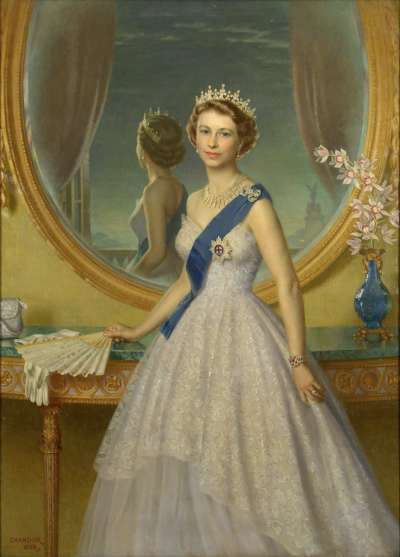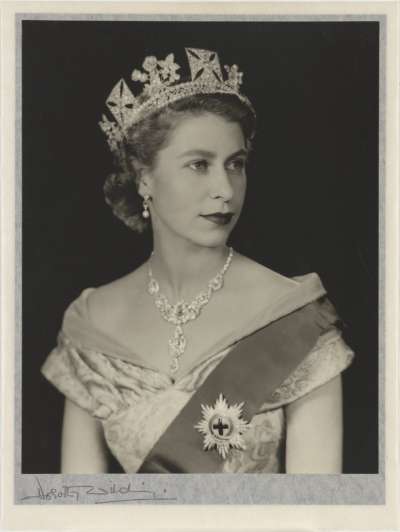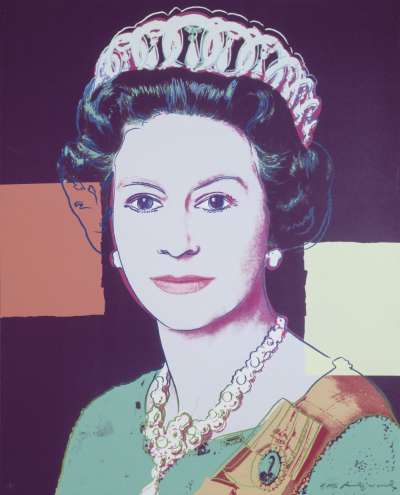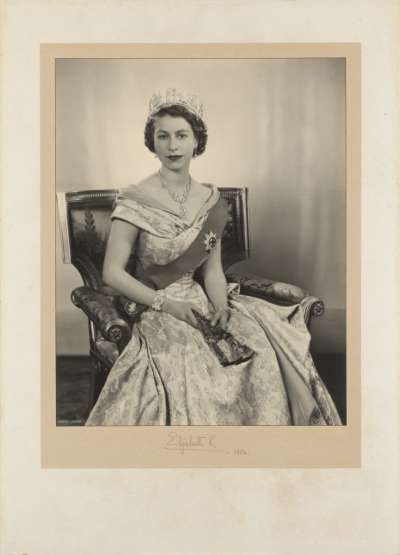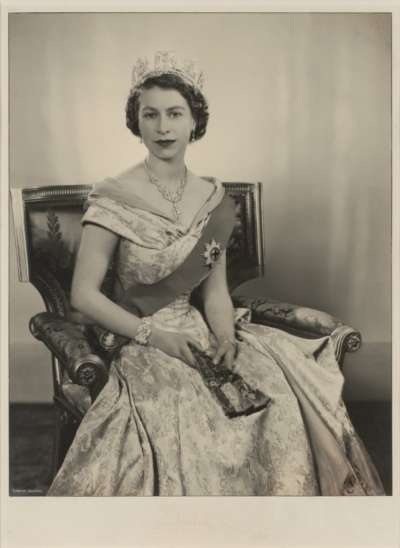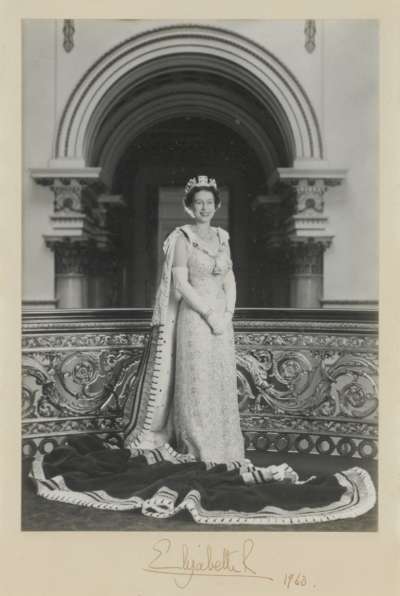Queen Elizabeth II in the Government Art Collection
Ruling from 1952 until 2022, Her Late Majesty Queen Elizabeth II was the longest-reigning monarch in British history, surpassing her great-great-grandmother Queen Victoria's 63-year reign. For over seven decades, she represented the UK as Head of State and of the Commonwealth around the world.
Displayed in government buildings across the globe, there are 39 separate depictions of the Queen in our Collection. Recognisable to thousands of visitors and staff, these images are intrinsically associated with British identity, culture and history. As we commemorate the monarch's life, we look at some of these iconic depictions of her in the Government Art Collection.
Andy Warhol, Queen Elizabeth II of the United Kingdom

Andy Warhol, Queen Elizabeth II of the United Kingdom – Reigning Queens – 3/40, screenprint, 1985 © 2016 The Andy Warhol Foundation for the Visual Arts, Inc / Artists Rights Society (ARS), New York and DACS, London.
Andy Warhol’s diamond-dusted screenprint portraits of the Queen are perhaps the most iconic in the Collection.
Warhol based his image on the official 1977 Jubilee portrait photograph of the Queen. Famous for reproducing images from popular culture, Warhol owned historical prints of Allan Ramsay’s coronation portraits of George III and Queen Charlotte. The historical tradition of copying royal portraits to send to embassies around the world fascinated Warhol.
Three of Warhol’s prints welcome visitors to the UK’s Ambassador’s Residences in Washington D.C. and New York.
Dorothy Wilding, HM Queen Elizabeth II
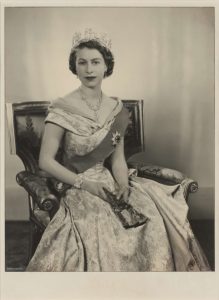
Dorothy Wilding, HM Queen Elizabeth II, photograph, 1952 © Estate of Dorothy Wilding
Just days after her father’s death in 1952, the new Queen sat for a state portrait by Dorothy Wilding.
This was not the first time they had met. Since the 1920s, Wilding had established a prominent career photographing actors, royalty and society in her Bond Street studio and became the first woman photographer to be granted ‘By Appointment’ status by the Royal Family.
Working from a temporary studio at Buckingham Palace, Wilding took 59 shots of the Queen. In this portrait, the Queen wears a diamond diadem, originally made for George IV in the 1820s. Over her evening gown designed by Norman Hartnell, is a blue riband, attached to which is the star of the Order of the Garter: the highest English order of chivalry. On her right wrist, she wears a diamond and platinum bracelet – a wedding gift from Prince Philip.
This 1952 image of the Queen inspired designs for banknotes and for ‘Wildings’ – postage stamps that were in circulation up to 1967. Copies were displayed at every British embassy. Today, Wilding’s photographs are on view in Gibraltar, Islamabad, Tehran and Mumbai, and in government buildings in Whitehall, London.
Matthew Corbin Bishop, Montserrat

Matthew Corbin Bishop (1984 – ), Montserrat, oil on canvas, 2008 © Matthew Corbin Bishop
Montserrat is one of seven oil paintings by Matthew Bishop Corbin from his 2008 series, The Making of the Modern World. The series replicates standard issue postage stamps from 1910 to the 1970s in British Overseas Territories. Five stamps feature the head of the reigning monarch at the time, either George VI or Elizabeth II, alongside landmarks, fauna or flora of each island. In Montserrat, Bishop painstakingly recreates the inked postmark that once overlaid the original stamp.
Bishop adapted the title of the series from the final paragraph of Niall Ferguson’s book Empire: How Britain Made the Modern World. Montserrat is currently on display at the Foreign, Commonwealth & Development Office in Whitehall, London.
Johannes Tessema, State Visit of Queen Elizabeth II to Ethiopia

Johannes Tessema, State Visit of Queen Elizabeth II to Ethiopia, 1965, oil on cotton, c.1965-1966 © Copyright Reserved / Johannes Tessema
The Queen made official visits to over 120 different countries in her lifetime, making her Britain’s most travelled monarch. In February 1965, on a state visit to East Africa, she was welcomed by Emperor Haile Selassie to Ethiopia.
In Ethiopian artist Johannes Tessema’s painting, the Queen and the Emperor are represented larger than others. The illustrated sequences show them riding in the Ethiopian State Coach to the Royal Palace, the Queen’s attendance at Parliament and a visit to the Blue Nile Falls. Originally presented to a former British Ambassador to Ethiopia in the 1970s, Tessema’s painting remains on view at the British Embassy in Addis Ababa.
David Dawson, Lucian Freud painting the Queen
We could turn up at the palace, jump out of the car – we’d go in, no one knew. It was all completely done quietly, without any fuss. And then the painting was made.
(David Dawson, The Observer, 4 April 2019)

David Dawson, Lucian Freud painting the Queen – 33/36, photograph, 2001 © David Dawson / Bridgeman Images 2021
In 2001, Lucian Freud asked to paint the Queen’s portrait (now in the Royal Collection). David Dawson, Freud’s longtime friend and studio assistant, photographed one of the 20 sittings of the Queen. Originally, these were intended to have taken place in Freud’s London studio, but this was abandoned after it was discovered by the press. Instead, Freud and Dawson arrived to meet the Queen each day at St James’s Palace.
Dawson’s photograph documents a startlingly informal and intimate moment. Resting on an easel between both figures is Freud’s small canvas on which he paints a close-up view of the Queen’s head. In a rare example of role reversal, the monarch becomes the artist’s ‘subject’.
Dawson’s photograph is displayed at the Ministry of Justice in London.
Damien Hirst, Beautiful Portrait, ‘The Queen’

Damien Hirst, Beautiful Portrait, ‘The Queen’, 2014 © Damien Hirst and Science Ltd. All rights reserved, DACS 2022.
In a nod to Warhol’s earlier reworking, Beautiful Portrait, Damien Hirst’s ‘The Queen’ is based on an official portrait, at the centre of one of Hirst’s spin paintings, a technique he began in 1994. Placing the portrait against a clash of colour, Hirst unites tradition and contemporary in one vibrant image.
Hirst produces his spin paintings by placing large circular canvases on a rotating turntable onto which paint and turpentine are flung, dropped and poured. Inspired by the drip paintings of American abstract expressionist Jackson Pollock, Hirst’s painting captures a sense of energy – but also a sense of time passing.
Hirst’s portrait of the Queen is on display in Whitehall, London.
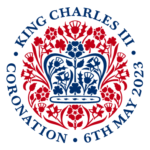
Explore the coronation with activities and stories inspired by our Collection.



